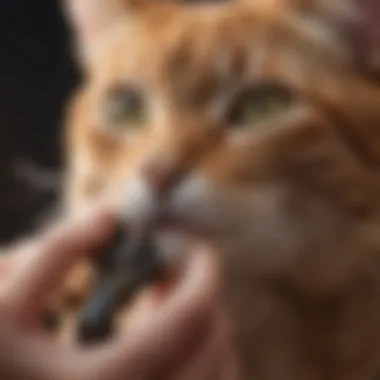Expert Guide on Safely Trimming Your Cat's Nails: Step-by-Step Tutorial


Pet Care Essentials
Trimming your cat's nails is an essential aspect of feline care. Not only does it prevent scratches on furniture and accidental injuries, but it also promotes the health and well-being of your furry companion. Regular nail trims are recommended to avoid overgrowth, splitting, or ingrown nails, which can be painful for your cat. By understanding the importance of maintaining your cat's nails, you are taking proactive steps towards ensuring their comfort and happiness. This guide will walk you through the process of safely trimming your cat's nails, providing you with step-by-step instructions for a stress-free grooming experience.
Daily Nutrition Requirements
Ensuring your cat receives proper nutrition is crucial for their overall health, including the condition of their nails. A balanced diet rich in essential nutrients, such as protein and vitamins, contributes to the strength of your cat's nails. Consult with your veterinarian to determine the best diet plan for your feline friend based on their age, weight, and any specific health concerns. Additionally, providing access to fresh water at all times is vital for hydration, which also plays a role in maintaining healthy nails.
Exercise and Playtime
Incorporating regular play sessions and physical activity into your cat's routine is not only beneficial for their physical health but also aids in keeping their nails trimmed naturally. Activities that encourage scratching, climbing, and running help wear down the nails and reduce the need for frequent trims. Interactive toys, scratching posts, and vertical spaces for climbing are excellent options to engage your cat and promote nail maintenance.
Grooming Tips
Apart from nail trims, grooming your cat regularly contributes to their overall well-being. Brushing your cat's fur helps prevent mats and tangles, while also allowing you to inspect their coat and skin for any abnormalities. Introducing grooming practices early and rewarding positive behavior can make grooming sessions more enjoyable for both you and your cat. By establishing a grooming routine that includes nail trims, you are prioritizing their grooming needs and strengthening your bond with your pet.
Health and Wellness Check-ins
Routine health check-ups with your veterinarian are essential for monitoring your cat's overall health, including their nail condition. During these visits, your veterinarian can inspect your cat's nails for signs of overgrowth, damage, or infection. They can also provide guidance on proper nail care techniques and identify any underlying health issues that may be affecting your cat's nails. By staying proactive about your cat's health and wellness, you are promoting a happy and healthy life for your feline companion.
Understanding the Importance of Cat Nail Trimming
Cat nail trimming is an essential aspect of feline care that often gets overlooked by pet owners. Regular nail trims are crucial for maintaining your cat's health and well-being, as overgrown nails can lead to a variety of issues. By understanding the importance of cat nail trimming, cat owners can ensure their furry companions remain comfortable and healthy.
Why Nail Trimming is Essential for Cats
The Role of Nail Trimming in Preventing Health Issues


One key role of nail trimming for cats is to prevent potential health problems. When a cat's nails are left untrimmed, they can grow too long and curl into the paw pads, causing pain and discomfort. This can lead to infections or ingrown nails, which may require veterinary intervention. By regularly trimming your cat's nails, you can avoid such health issues and keep your cat pain-free.
Impact of Overgrown Nails on a Cat's Well-being
The impact of overgrown nails on a cat's well-being is significant. Cats with long nails may alter their gait to compensate for the discomfort, leading to joint strain and potential mobility issues. Additionally, overgrown nails can get caught in objects or furniture, causing injury to the cat or damage to property. By addressing this aspect of feline care through regular nail trims, cat owners can promote a comfortable and safe environment for their pets.
When to Trim Your Cat's Nails
Signs Your Cat's Nails Need Trimming
Recognizing the signs that indicate your cat's nails need trimming is essential. Common indications include clicking sounds when your cat walks on hard surfaces, visible long nails, or discomfort while walking. By being attentive to these signs, cat owners can timely address their cat's nail care needs and prevent any related health issues or discomfort.
Frequency of Nail Trims Based on Cat's Lifestyle
The frequency of nail trims for cats can vary based on their lifestyle. Indoor cats typically require more frequent trims compared to outdoor cats, as they have fewer opportunities to naturally wear down their nails. Regularly trimming your cat's nails ensures they remain at a manageable length, promoting their comfort and overall well-being. Understanding your cat's lifestyle and habits can help you determine the appropriate trimming schedule to keep their nails healthy and maintained.
Preparation for Cat Nail Trimming
In this article, the preparation for cat nail trimming is crucial as it sets the foundation for a successful grooming session. Proper preparation not only ensures the safety and comfort of your feline friend but also facilitates an effective nail trimming process. By engaging in adequate preparation, cat owners can minimize stress and potential risks associated with nail trimming, making it a more pleasant experience for both the pet and the owner.
Gathering Necessary Supplies
Choosing the Right Nail Trimming Tools
Selecting the appropriate nail trimming tools is paramount in ensuring a smooth and efficient nail trimming session. The choice of tools plays a significant role in the success of the grooming process. Emphasizing on high-quality clippers that are suitable for cat nails can make the task easier and less stressful. Opting for tools with sharp blades and a comfortable grip can enhance precision and reduce the likelihood of accidental injuries. It is essential to prioritize safety and effectiveness when choosing nail trimming tools to promote a positive experience for your cat while achieving the desired results.
Additional Items for a Smooth Nail Trimming Session
In addition to nail trimming tools, incorporating additional items can contribute to a seamless grooming session. Items such as styptic powder for potential bleeding, treats for positive reinforcement, and a towel to restrain the cat gently can enhance the overall experience. These supplementary items serve different purposes, from aiding in case of emergencies to providing rewards for cooperation during the nail trimming process. Integrating these additional items into the grooming routine can improve efficiency and help cat owners navigate potential challenges with ease.


Creating a Calm Environment
Establishing a calm and conducive environment is essential for a successful nail trimming session. Minimizing stress and anxiety for your cat is paramount in ensuring their comfort and cooperation during the grooming process. By eliminating potential stressors such as loud noises or sudden movements, cat owners can create a relaxing atmosphere that promotes relaxation and tranquility for their feline companion.
Minimizing Stress and Anxiety for Your Cat
Reducing stress and anxiety levels in cats is crucial for a positive grooming experience. Cat owners can achieve this by gradually introducing the cat to the grooming area, offering familiar scents and gentle interactions, and maintaining a quiet and soothing environment. By understanding their pet's cues and responding accordingly, owners can alleviate anxiety and create a more enjoyable grooming session for their cat.
Utilizing Treats and Positive Reinforcement
Utilizing treats and positive reinforcement techniques can encourage desirable behavior during nail trimming. Offering rewards for good behavior can help cats associate the grooming process with positivity and reinforcement. By incorporating treats as a form of motivation and praise, cat owners can reinforce calm and cooperative behavior, making future nail trimming sessions more manageable and less stressful for both the pet and the owner.
Step-by-Step Guide to Trimming Your Cat's Nails
Restrain Your Cat Safely
Choosing the Right Position for Trimming
When it comes to Choosing the Right Position for Trimming your cat's nails, consider a spot where your cat feels secure and comfortable. Opt for a quiet room with minimal distractions to minimize the stress levels for your feline friend. Positioning your cat in a familiar environment helps foster a sense of trust, making the nail trimming experience less daunting. Ensure proper lighting to avoid any mishaps during the process. By choosing the right position, you can establish a conducive setting for a successful nail trimming session.
Avoiding Injury to Your Cat and Yourself
Avoiding Injury to Your Cat and Yourself is essential during nail trimming to maintain a safe and comfortable experience for both you and your cat. Use high-quality nail clippers designed for cats to minimize the risk of accidents. Handle your cat gently but securely to prevent sudden movements that could lead to cuts or nicks. Be cautious of the quick, the sensitive blood vessel inside the nail, to avoid causing pain or bleeding. By employing careful techniques and staying attuned to your cat's reactions, you can trim their nails effectively without any harm.
Identifying the Quick and Proper Clipping Technique
Tips for Locating the Quick in Your Cat's Nails


A critical aspect of the nail trimming process involves mastering the art of Tips for Locating the Quick in Your Cat's Nails. The quick is the pink area within the nail that contains blood vessels and nerves. To identify the quick, examine your cat's nails under a bright light to distinguish the translucent portion from the pink region. Trimming too close to the quick can cause pain and bleeding, so it's crucial to locate it accurately before clipping. By understanding how to pinpoint the quick, you can trim your cat's nails with precision and care.
Executing the Clipping Motion with Precision
Executing the Clipping Motion with Precision requires a steady hand and attention to detail. Position the nail clipper perpendicular to the nail and make swift, controlled cuts to avoid splintering or crushing the nail. Use a gradual approach by trimming small sections of the nail to prevent cutting into the quick accidentally. Maintain a calm demeanor during the clipping process to reassure your cat and ensure a smooth experience. By mastering the clipping technique, you can keep your cat's nails at the optimal length without causing any discomfort.
Dealing with Potential Challenges
Strategies for Handling Resistant Cats
When faced with a resistant cat during nail trimming, employ Strategies for Handling Resistant Cats to overcome the reluctance and complete the task successfully. Start by introducing your cat to nail clipping gradually, offering treats and positive reinforcement to associate the activity with rewards. If your cat remains uncooperative, enlist the help of a professional groomer or veterinarian for assistance. Patience and gentle handling are key in managing resistant behavior and ensuring the safety of both you and your cat.
How to Stop Bleeding if You Accidentally Cut the Quick
In the event of accidentally cutting the quick and causing bleeding, knowing How to Stop Bleeding is crucial to minimize discomfort for your cat. Apply styptic powder or a styptic pencil to the affected nail to aid in coagulation and stem the bleeding. Maintain pressure on the nail for a few minutes until the bleeding subsides. If bleeding persists, seek veterinary advice promptly to prevent any complications. By acting swiftly and effectively, you can manage bleeding incidents during nail trimming and ensure a quick recovery for your feline companion.
Aftercare and Positive Reinforcement
After trimming your cat's nails, providing proper aftercare and positive reinforcement is essential for their wellbeing. This section focuses on two key aspects: rewarding your cat after nail trimming and monitoring their nails for future trims.
Rewarding Your Cat After Nail Trimming
Encouraging positive behavior in your cat post-nail trimming session is crucial. Using treats and affection as a form of positive reinforcement has shown to be highly effective. The act of providing treats and affection creates a positive association with the grooming process, making your feline friend more cooperative during future sessions. This strategy not only reinforces good behavior but also strengthens the bond between you and your cat. Ensuring consistent and gentle positive reinforcement establishes trust and reduces stress for your cat, enhancing the overall grooming experience.
Creating a Bonding Moment After the Trimming Session
Another vital aspect of aftercare is creating a bonding moment post-trim. This involves spending quality time with your cat in a calm and relaxing environment. Engaging in activities that your cat enjoys, such as interactive play or gentle petting, helps further reinforce the positive experience of nail trimming. Bonding sessions after grooming not only provide comfort and reassurance but also help alleviate any lingering stress or anxiety your cat may have experienced during the nail trimming process. By fostering a nurturing post-trim environment, you promote trust and security, establishing a positive routine for future grooming sessions.
Monitoring Your Cat's Nails for Future Trims
Regularly monitoring your cat's nails is crucial for maintaining their health and well-being. Understanding the signs that indicate the need for another nail trim is essential. Look out for nails that appear overgrown, curling, or causing discomfort to your cat. These are clear indications that another trimming session is warranted. By staying vigilant and proactive in monitoring your cat's nails, you can prevent potential issues such as ingrown nails or difficulty walking.
Scheduling Regular Nail Maintenance Sessions
Incorporating regular nail maintenance sessions into your cat's grooming routine is key to their overall paw health. Scheduling these sessions at appropriate intervals, based on your cat's individual nail growth rate, ensures that their nails remain at a manageable length. By establishing a consistent trimming schedule, you mitigate the risks associated with overgrown nails and maintain their paw comfort. Additionally, regular nail trims contribute to the overall well-being of your cat, promoting healthy paws and reducing the likelihood of nail-related complications. By adhering to a structured nail maintenance plan, you demonstrate your commitment to your cat's grooming needs and proactive care, fostering a strong bond built on trust and attentiveness.







